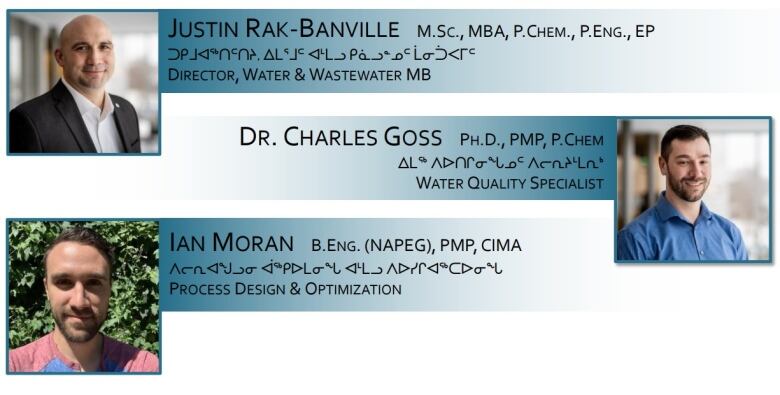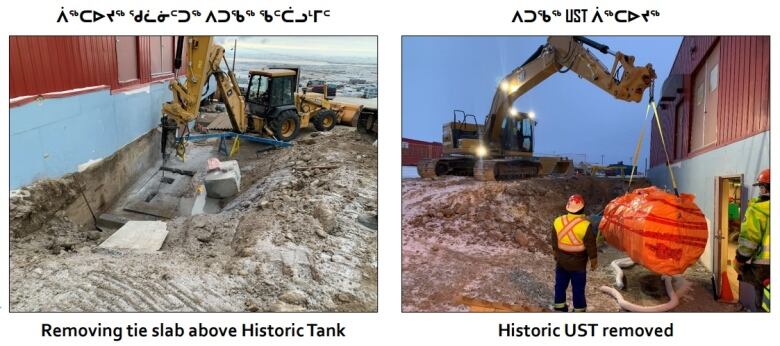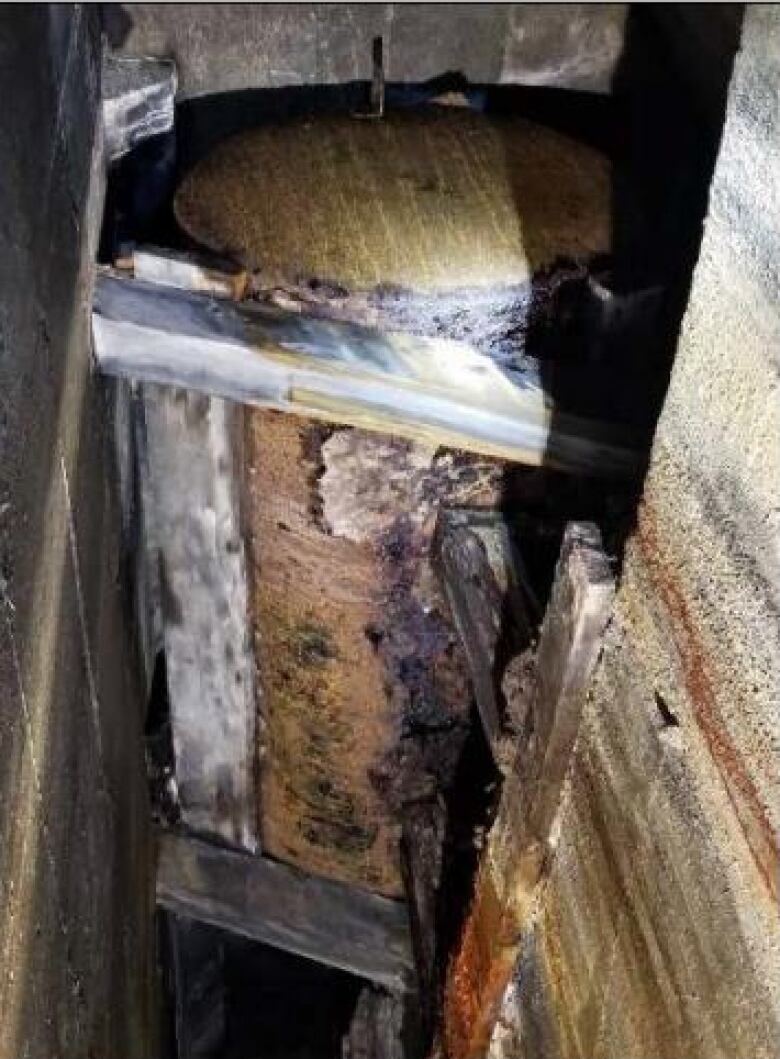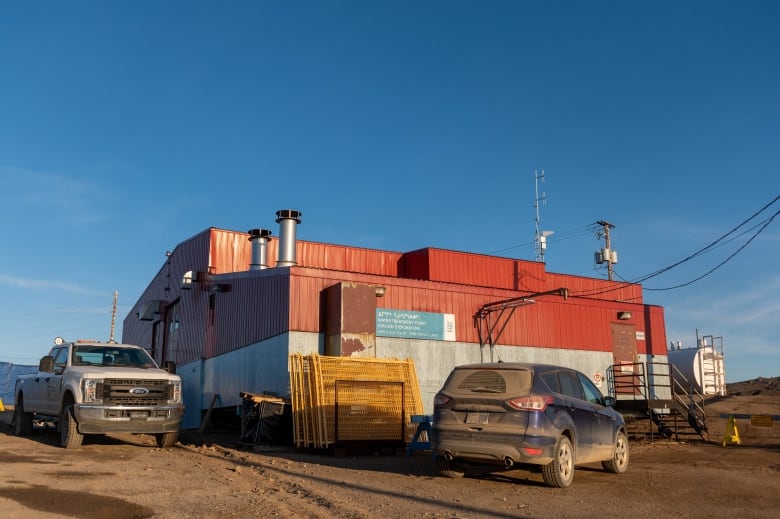An old fuel tank and 'the void' contaminated Iqaluit's water, experts say
Mayor and council heard a report from a team of investigators and remediation experts Thursday

On Thursday, Iqaluit city councillors heard a report from consultants who explained just how an aging fuel tank contaminated the city's water supply, and what steps it needed to take to fix the problem.
Ian Moran, a water treatment process design engineer with WSP engineering firm, explained how the WSP team worked to find the "fingerprint" of petroleum hydrocarbons detected in October and againin January.
The City of Iqaluit hired the firm in October, when Iqaluit residents reported a strong fuel smell in their drinking water. A state of emergency stemming from undrinkable tap water was declaredOct. 12, and would go on to last nearly two months. Five weeks later, residents again reported smelling fuel in the water, leading to a nine-day boil water advisory.
WSP'sinvestigation found there were two distinct sources of contamination. In October, fuel vapours from a degraded fuel tankled to vapours seeping into a surge tank, and eventually into the raw water tank where it contaminated the filtered water supply.
But in January, the contamination came from a tar-like substance which was affixed to holding tanks in 2003 and became exposed.

It all started on Oct. 12, when the city found contamination on the surface of a below-ground treated water tank known as the North Clearwell and ordered people not to drink the water.
In November, the Government of Nunavut was still askingresidents not to use their tap water for drinking or cooking.
The city was trying to rule out the source of contamination, and beefed up its monitoring systems so it could detect hydrocarbons at multiple points of the distribution system, said Moran.
One week after Iqaluit residents first reported smellingfuel in their water, WSP staff landed in Iqaluit to inspect the plant and water supply system, looking at all exterior components of the plant, Lake Geraldine, the raw water intake, treated water reservoirs and components of the distribution system.
There was no "sheen" visible on Lake Geraldine and all the parts appeared to be in working order and had no signs of tampering.
Then, they stepped into the void.
Contaminated 'void'
The"void,"whichserves no specific purpose for water treatment, isan area between the water plant and bedrock, and an aging fuel tank.
The consultants found the 60-year-old underground fuel storage tank, which has since been removed, was leaking into the void, where it then seeped through concrete and into a surge tank.

City councillors heard from Dr. Charles Goss, WSP's team lead for water treatment, who confirmed the fuel tank to be the source of October's contamination, by establishing the fingerprint of a variety of hydrocarbons found in various areas of the treatment plant.
The void, or "confined" space between bedrock and the treatment plant, had nearly one metre of standing water, and contamination from an aging fuel tank dripping into it, said Moran.
"In the furthest reaches of the void, we observed a historic underground fuel storage tank in an advanced state of deterioration," he said.
The investigation found a surge tank below ground to bepartially submerged in the contaminated water, said Moran.
Investigators also found "heavy oil contamination on the walls, ladder, rungs and on the water surface" of a raw water storage tank, where water is held before the filtration stage.
After discovering this, the city isolated the raw water tank and by Oct. 24, fuel concentrations diminished.
In November, the city removed the aging fuel tank, which was covered by a concrete slab, backfill and an accessibility ramp.

To remove it, they had to cut a rectangle of concrete around the fuel tank and remove it from the ground.
They also cleaned up the void and pressure-washed and cleaned all below-ground tanks to remove any trace amounts of contamination.
They installed a monitoring system that day, and a second monitoring station on the raw water line in December.
This helped the city detect and isolate the source of a separate and unrelated source of fuel contamination in January.
This time, they traced it back to the below-ground treated water tanks.
The city shut down the water plant, flushed the system and prevented detectable levels of hydrocarbons from entering the distribution system, said Moran.
January smell from 'tar-like' substance
Fuel smells detected in January had the fingerprints of an entirely different source a tar-like substance, applied to concrete holding tanks in 2003 andused as a waterstop,consultants told Iqaluit city council.
Between Jan. 14 and Jan. 17, the city got more than 100 complaints of fuel smell in their taps.
WSP returned and used ground-penetrating radar on the below-ground tanks, finding two "very different" qualities of walls, said Moran.

The consultants said that while the waterstop was certified for use at the time of the repairs,itis no longer certified nor would it be used in modern plant construction.
The material was covered with a thin grout-like layer that had degraded over time, exposing it and allowing it to come in contact the water in the tanks, the city said in a news release Thursday evening.
WSP said it has proposed several recommendations to the city for addressing the waterstop product, including removing all applications of the product in places where it is not specified for use as concrete cover.
The way forward
The City of Iqaluit has been using the water treatment bypass system which uses ultraviolet disinfection followed by chlorination of water from Lake Geraldine, to avoid contact with the below ground tanks, consultants explained in the presentation.
Iqaluit's water samples tested between Oct. 12and Thursday have not exceeded Health Canada's drinking water screening values, said Moran.

Coun. Kyle Sheppard said it was a "big relief to have this information availableto provide for residents so that we can hopefully provide some peace of mind going forward."
"There's very compelling evidence and compelling data in this report. To me, it's undoubted, what the source of this contamination was," he said.
The consultants said as part of their work, they launched an environmental assessment of the areas surrounding the water treatment plant and used ground-penetrating radar to detect any possible cracks in the water treatment infrastructure.
On Friday morning, the city issued yet another boil water advisory to residents, citing a mechanical failure.
Bell said Thursday he looked forward to using $214 million in federal funding to fix the city's ongoing water supply issue, "which is going to help the city grow in the way it should."
Bell also thanked residents who endured months of do-not-consume advisories.
"We're not out of the woods yet, but we know what happened. We know how to fix it."
Corrections
- An earlier version of this report incorrectly attributed a statement that was in fact made by Coun. Kyle Sheppard.May 06, 2022 1:03 PM CT












_(720p).jpg)


 OFFICIAL HD MUSIC VIDEO.jpg)
.jpg)



























































































